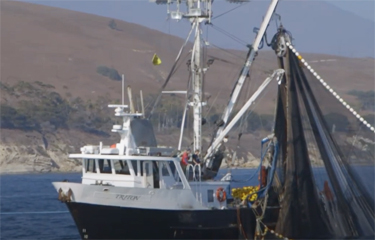The Pacific sardine fishery on the U.S. West Coast has officially been given a rebuilding plan by the Pacific Fishery Management Council (PFMC), a move that fishermen applauded and environmental organization Oceana has decried as a “failure to act.”
The development is the latest in years of complications for the fishery, which was closed in 2015 after surveys showed a lack of acceptable biomass in the species. The most recent assessment by NOAA earlier this year looked as though the fishery was on track for yet another year of closures.
That assessment estimated that the Pacific sardine biomass would be at 27,547 metric tons (MT) by the summer months. The fishery needs 150,000 MT of biomass at a minimum to be open to commercial fishing, and any fishery with less than 50,000 MT of biomass is considered overfished. Those low numbers are a sharp contrast to just a few years ago – sardine biomass was estimated at around 1.8 million MT in 2006.
The string of low assessments has resulted in the PFMC establishing a rebuilding plan, intended to achieve a balance between the need to conserve the stocks, and the fishing communities that rely on them. The PFMC unanimously chose Alternative 1 among the rebuilding plans, or the “status quo” plan, which targets achieving 150,000 MT of biomass.
The initial recommendations, according to a presentation on the subject given by the Coastal Pelagic Species Management Team, is based on more than just modeling results; it uses historical information on sardine abundance, historical information on the fishery, and the socio-economics of the fishing industry and communities it supports.
The Pacific sardine fishery has been facing a more complicated plight than just a lack of biomass – the species has long been separated into northern and southern groups, based on water temperatures. As temperatures in the Pacific have been rising over the last decade, more sardines are located in water that’s 62 degrees Fahrenheit and above – making them part of the southern stock.
The California Wetfish Producers Association (CWPA) – which supported the recent decision by the PFMC – has long argued that if the stocks were combined, the sardine stock wouldn’t be considered overfished.
“The council decision illuminates a dicey problem: sardine fishery management policy assumes that two sardine stocks exist along the west coast and Mexico, divided by a temperature barrier at about 62 degrees F[arenheit],” a press release by the CWPA said. “But the council manages only the “northern” stock, and in recent years, stock assessments have subtracted thousands of tons of sardines found in waters warmer than 62 degrees on the assumption that those were ‘southern’ sardines that migrated up from Mexico.”
Due to the timing of NOAA surveys, and the timing of sardine migrations, most sardines surveyed are in waters above 62 degrees. That means those sardines are not taken as part of the northern stock, reducing the biomass number.
“For the past few years, fishermen have testified to a growing abundance of sardines on their fishing grounds yearlong,” the CWPA wrote. “But complicating matters even further, for management purposes, all sardines landed are subtracted from the 'northern' sardine harvest allowance, regardless of sea temperature. This catch-22 sets the back-story for the council’s final decision.”
According to CWPA Executive Director Diane Pleschner-Steele, the decision reflects the PFMC’s understanding of the wider issues at play.
"The council's unanimous decision to support the management team's recommendations shows that they understand reality, the big picture," Pleschner-Steele said. "Our sardine harvest policy already has a built-in rebuilding plan. The council closed the main directed fishery in 2015, and sharply reduced incidental harvest rates last year. Further cuts would drive many fishing businesses out of business, and we appreciate the council's acknowledgement of that prospect."
Environmental group Oceana, however, has a very different view of the recent decision. Soon after the council reached its decision, the group called it a failure to take action on the rebuilding of the species.
Oceana said that the decision to go with the “status quo” approach presented by Alternative 1 will only hasten the collapse of the fishery, which has collapsed in the past. Back in the 1970s, the group stated, a failure to manage the fishery led the California legislature to place a complete moratorium on all sardine fishing in 1974, and the population didn’t recover until 1990.
“Sardine populations are known to boom and bust. However, science shows that fishing exacerbates natural declines and delays recovery,” Oceana stated.
The CWPA responded to Oceana’s claims soon after, countering the environmental group’s assertion that the management measures didn’t go far enough.
“Oceana’s accusation, ‘fishery managers have failed to learn from the mistakes of history,’ does not pass the straight-face test when all the facts are presented,” the CWPA wrote. “During the great sardine decline in the late 1940s, the historic sardine fishery harvested 50 percent or more of the standing stock. Today’s sardine fishery harvest amounts to only 0.6 percent of the northern sardine population – very close to zero U.S. harvest, which was modeled as Alternative 2, and showed disastrous economic impacts to fishing communities in California and the West Coast because it curtailed major fisheries.”
Still, Oceana asserts that the PFMC is ignoring the science.
“Fishery managers have failed to learn from the mistakes of history, and if they don’t act soon we’ll be doomed to repeat them and continue on an irresponsible pathway that will devastate the sardine population and its prospects for recovery,” Oceana Senior Scientist Geoff Shester said in an Oceana release. “It is disappointing that again California wildlife officials, federal managers, and the fishing industry are disregarding the science in order to avoid making hard choices. Today’s decision is a failure of responsible fishery management.”
Photo courtesy of California Wetfish Producers Association







